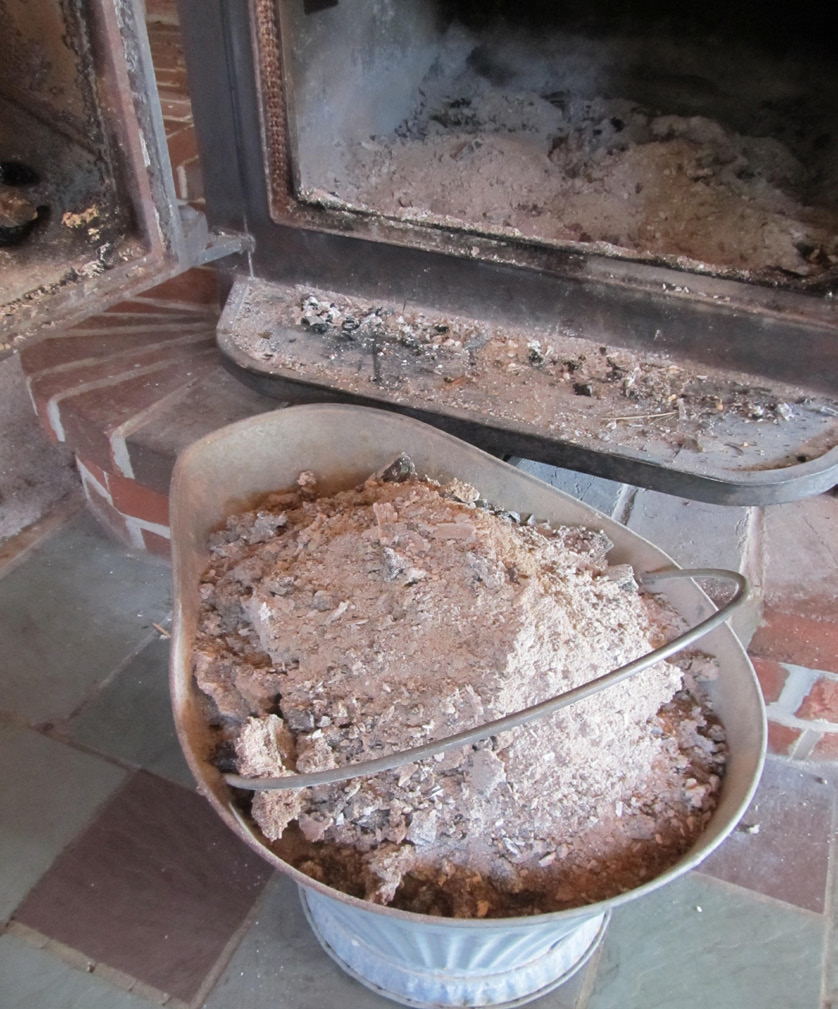Introduction
Wood ash has a long history of use in New England. Our Yankee ancestors used wood ash to make lye for soaps, to clean glass, silver and pewter. Ash is also used as an agricultural soil amendment to add nutrients and raise the soil pH. Burning wood is still very popular in New England and sources are readily available. This document is focused primarily on the use of ash from residential woodstoves, but touches on the use of ash from larger commercial sources such as wood-burning biomass plants which produce heat or electricity.
"Wood ash contains significant amounts of potassium and calcium, while providing smaller amounts of phosphorous and magnesium."
Benefits
Many home gardeners and farmers choose to use wood ash as a soil amendment. Wood ash contains significant amounts of potassium and calcium, while providing smaller amounts of phosphorous and magnesium and micronutrients like zinc and copper. If your soil is deficient in these nutrients, using wood ash is a great way to supplement yourgarden’s needs. Wood ash contains a significant am ount of calcium, the primary substitute for lime to increase the pH of acidic soils. Wood ash is a natural substitute for lime to help maintain proper soil pH.
Benefits: Recycles wastes, Increases soil pH, Add plant nutrients, Low cost
Wood Ash as a Liming Agent
Soil pH is a measure of the soils relative acidity or alkalinity. Most crops grow best in a slightly acidic soil with a pH between 6.0-6.8. New Hampshire soils are naturally acidic and periodic liming is necessary to maintain agricultural productivity. Acidic soils (below a pH of 6.0) reduce the availability of most plant nutrients and can reduce biological activity in the soil. Wood ash is more soluble and reactive than ground limestone, and brings about a change in soil pH more quickly than lime. Lime can take 6 months to 1-year to fully take effect. Most commercial sources of wood ash will test the CCE or the Calcium Carbonate Equivalent. This measurement will tell you how well the product will raise the soil pH compared to pure calcium carbonate, the active ingredient in limestone. Because of the nature of wood ash, it is not as concentrated in CCE as lime, thus more product is needed to have the same impact on soil pH. Where the CCE of lime is 90-95%, wood ash can vary anywhere from 25-59% CCE; thus, you would need to use 2-4 times as much wood ash as you would limestone in order to see the same response. There can be large differences in how effectively wood ash increases soil pH. If purchasing wood ash from a supplier, it is best to ask for the CCE number.
The amount of wood ash required for your soil should be determined though soil testing. Recommendations are based on the current soil pH, target pH, and the soil’s buffering capacity – a measure of how readily pH changes in the soil depending on its clay and organic matter content.
Some plants, like blueberries, rhododendrons and scab-susceptible potatoes varieties thrive in acid soils,and should not be supplemented with wood ash, unless recommended by a soil test. Too much wood ash can raise the soil pH higher than optimal, which can negatively impact plant nutrient uptake.

How to Apply
A soil test will determine relative needs. It is best to know your soil pH before applying your wood ash. However, a typical garden of 1,000 square feet with a pH of 6.5 would generally require no more than 20 pounds of wood ash (enough to fill a five-gallon bucket). Once applied, mix material into the top 2-4 inches, no additional wood ash should be needed that year. Similarly, you can apply a maintenance application of 10-15 lbs of ash to your 1,000 sq. ft. lawn each year.
While fall applications are recommended, you can also apply materials in the spring. Avoid applying ash to germinating seeds. The high salt content can negatively affect germination. Dust can be a problem when spreading large amounts of material, therefore ash should be stored in a suitable location away from buildings. If needed, water can be added. Avoid overwatering material as it can become cake-like and difficult to apply. If transporting material, the ash should always be covered. It is best to field apply material on a humid, low-wind day.
"Wood ash is more soluble and reactive than ground limestone, and brings about a change in soil pH more quickly than lime."

Safety with Wood Ash
Wood ash is a liming material and therefore caustic, protective equipment should be used during application. This includes eye protection, gloves, long sleeves and a mask if using very fine material.
USE COMMON SENSE.
Do not mix ash with nitrogen fertilizers such as ammonium sulfate (21-0-0-24S), urea (46-0-0) or ammonium nitrate (34-0-0). These fertilizers produce ammonia gas when placed in contact with high pH materials such as wood ash.
"Do not mix ash with nitrogen fertilizers as ammonium sulfate (21-0-0-24S), urea (46-0-0) or ammonium nitrate (34-0-0). These fertilizers produce ammonia gas when placed in contact with high pH materials such as wood ash."
Other Soil Nutrients Receive From Wood Ash
Wood ash is a good source potassium (K) ~5%, calcium (Ca) ~25%, phosphorous (P) ~2%, and magnesium (Mg) ~1% which are essential plant nutrients. Crops have been shown to positively respond to K and P from wood ash. Other micro-nutrients in wood ash include boron, copper, molybdenum, sulfur and zinc. Never use wood ashes from garbage, pressure treated or painted wood as it can contain heavy metals and materials which are toxic to plants. Trace amounts of heavy metals are contained in most wood ash material, therefore caution should be used when handling the material.

Commercial Wood Ash
The New Hampshire Department of Environmental Services (DES) regulates the distribution and utilization of commercial-grade wood ash in accordance to Env-Sw 1700 requirements for land application of wood ash. Anyone generating or distributing more than 500 tons of wood ash annually needs a certification from NH-DES to do so. Producers who create less than 500 tons annually are currently exempt from this rule but it is recommended that they follow the same practices for managing wood ash as summarized below.
Companies providing wood ash from commercial sources should provide analytical results and give assistance in determining appropriate application rates. In general, wood ash from commercial sources is not quite as concentrated in nutrients as the wood ash from residential wood stoves.
Typically the application rate for 1 ton of lime equivalent will be 3 tons of wood ash. Wood ash from any commercial/industrial source should be analyzed for nutrient and trace metal content prior to being used as a soil amendment. Wood ash is an excellent alternative to commercial fertilizer and should be used in accordance with best management practices for storing and spreading fertilizers
Maintaining a buffer from waterways and spreading at agronomic rates based on soil tests and crop needs is the best way to maximize agricultural benefits and environmental stewardship.
If you produce or distribute over 500 tons of wood ash per year, you fall under NH DES regulations. Contact NH DES if you have questions. (https://www.des.nh.gov/)

References
University of Maine, Cooperative Extension Bulletin #2279, Using Wood Ash on Your Farm.
By T.S. Griffin. https://extension.umaine.edu/publications/wp-content/uploads/sites/82/2015/04/2279.pdf
New England Vegetable Management Guide - 2018. Fundamentals of Soil Fertility.
https://nevegetable.org/cultural-practices/soil-acidity-ph-and-liming
NH Department of Environmental Services
Solid Waste Permitting and Design Review Section Solid Waste Wood Ash certification.
https://des.nh.gov/organization/divisions/waste/ swmb/pdrs/permit-sw-wood-certification.htm
About the Author: Olivia Saunders is the Food & Agriculture Field Specialist in Carroll County with UNH Cooperative Extension. Olivia coordinates the UNH soil testing program and is on the fruit and vegetable team at UNH Cooperative Extension.
For More Information
State Office
Taylor Hall
59 College Rd.
Durham, NH 03824
https://extension.unh.edu
Education Center and Infoline
answers@unh.edu
1-877-EXT-GROW
(1-877-398-4769)
9 a.m.-2 p.m. M-F
extension.unh.edu/askunhextension


